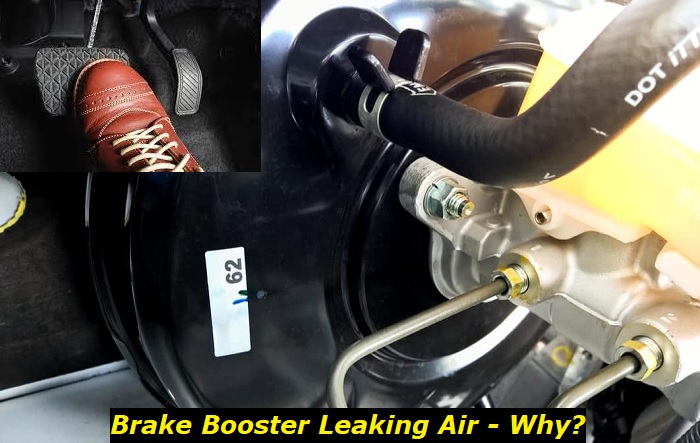The brake booster is an important component of a vehicle's braking system that offers several benefits including improved stopping power, increased pedal efficiency, reduced brake fade, and better fuel economy. It is therefore essential for all vehicles to have functioning brake boosters for optimum performance and safety on the roads.
Common brake problems highlights
- Level of urgency:super-urgent
- DIY diagnostics:possible but not recommended
- DIY repairs:impossible
- Price for repair:$150 - $450
- Common symptoms:issues with braking, car brakes on its own, brakes are inefficient, sounds when braking
- Commonreasons:fluid issues, caliper problems, cylinders problems, brake booster issues
- If ignored:no brakes, accidents, dangerous situations

How the Brake Booster Works
The brake booster, as its name implies, is an important component of a vehicle's braking system. Also referred to as the brake servo or vacuum booster, it works in conjunction with the master cylinder, assisting it when the driver depresses the brake pedal.
When this happens, the pressure generated by the movement of the pedal activates the power booster, which in turn amplifies this pressure and sends it to activate other parts of the braking system, such as the calipers or wheel cylinders. This amplified pressure ensures that brakes are applied efficiently and quickly while using minimal effort on behalf of the driver.
Benefits of a Properly Working Brake Booster
The brake booster serves an important function in your vehicle. So, you have to ensure that it is working optimally to fully utilize its advantages. With everything in order, the brake booster offers several benefits to a vehicle:
1. Improved Stopping Power
By amplifying the available force from pressing down on the brake pedal, there is more power sent through to operate components such as calipers and wheel cylinders. This translates to a quicker stopping power for the vehicle.
2. Increased Pedal Efficiency
The amplified force also means less effort is needed from the driver to activate braking components. As a result, drivers can react quicker in emergency situations and they feel greater confidence in their ability to stop the vehicle.
3. Reduced Brake Fade
By using a power booster, there is less stress on certain parts of the braking system such as calipers or wheel cylinders. This helps reduce the likelihood of brake fade, which occurs when brakes get overheated due to excessive use.
4. Better Fuel Economy
When the brake booster is functioning properly, it helps ensure that brakes are applied only with sufficient force, which reduces wear and tear on them over time. This in turn helps to improve fuel economy, as brakes are not working too hard when they don't need to be.
Signs of Air Leakage from the Brake Booster
Recognizing the signs of air leakage from the brake booster is a crucial step in the preservation of the integrity of your vehicle. Doing so will help you detect and find a solution for the problem without further delay, which will help you mitigate its negative effects on your car and save you from more expensive repairs down the line.
Air Leakage from the brake booster can manifest through the following symptoms:
1. Hissing Noise in the Engine Bay
When the brake booster is failing, one of the most common signs is air leakage. As vacuum pressure inside the brake booster decreases, a hissing noise may be heard coming from under the hood. This is an indication that air is escaping through any cracks or holes in the chamber walls.
2. Spongy Brakes
Additionally, if air pressure drops too low, it can cause a "spongy" feeling when pressing down on the brake pedal as it will not offer sufficient resistance. In some cases, this sponginess may lead to long periods of travel before engaging the brakes and stopping.
3. Significantly Reduced Braking Power
Finally, if there is a complete loss of vacuum pressure due to a large crack or hole in the chamber wall or seal failure, braking power will be severely reduced and may even become unpredictable. This is due to the valve not closing properly and allowing a large amount of air into the chamber, reducing the braking force from the brakes.
It should be noted that these symptoms can vary depending on how much vacuum pressure has been lost in the brake booster, so it is important to have any issues inspected by an experienced mechanic as soon as possible.
Most Common Causes of Leaking Air from the Brake Booster
Be sure to check for signs of air leakage from the brake booster on a regular basis and have any issues inspected by a qualified mechanic as much as possible. However, there can be many causes of air leakage from the brake booster, with some being more common than others.
These typically include a faulty diaphragm/valve, cracked chamber walls, a damaged vacuum hose, a faulty check valve, and oil saturation. Quickly diagnosing and rectifying these issues can help minimize further damage to your vehicle's brakes and save you money in the long run.
Here's a quick rundown of the most common causes of a brake booster failure that can lead to air leaks:
1. Faulty Diaphragm/Valve
The diaphragm or valve in the brake booster is responsible for closing and opening while allowing suction and pressure as required. When this part fails, it often leads to a loss of vacuum pressure due to improper sealing of the chamber walls. This will result in decreased braking power and an increase in air leakage.
2. Cracked Chamber Walls
As mentioned earlier, the vacuum created inside the brake booster relies on a tight seal between its chamber walls. If these walls become damaged or cracked over time due to wear and tear, air can escape and lead to a reduction in brake performance.
3. Damaged Vacuum Hose
The hose connecting the brake booster to the engine is responsible for carrying air between the two compartments. If it becomes damaged or clogged with dirt and debris, this can interrupt the flow of air and cause a loss of vacuum pressure inside the brake booster.
4. Faulty Check Valve
A check valve located in one of the hoses leading from the engine to the brake booster helps ensure that air flows only one way (from the engine to the chamber). However, when this part fails due to wear or damage, it can allow air to leak out of the chamber, lowering its efficiency and power output.
5. Oil Saturation
Oil saturation is a condition where oil has accumulated inside the brake booster, reducing its ability to generate suction and pressure as required. This often leads to an increased amount of air leakage from the chamber walls, resulting in decreased braking power.
Solutions to a Failing Brake Booster with Air Leakage
Normally, a damaged part within the brake booster already calls for a replacement of the entire assembly. Depending on the kind of vehicle that you have and other factors in your area, the average cost of replacing this part can be somewhere between $325 and $1,250.
Breaking the numbers down, the parts alone could set you back from $100 to $900. Next, labor could get you around $100 to $200. On the other hand, if the repairs only involve the replacement of parts separate or independent from the brake booster such as hoses, seals, check valves, and others, then you might get away with a cheaper bill that will only cover any of the said components.
This is also true if the cause of the issue can only be remedied by merely cleaning the parts and adding lubrication.
By following these simple steps, you should be able to ensure that your vehicle's brake booster remains in good working condition and provides you with years of reliable service. Do not hesitate to seek help if you experience any issues or have questions about your brake booster. A qualified mechanic can help diagnose the root cause of air leakage from the brake booster and determine the best course of action for its solution.
Conclusion
Although there are no 100% guarantees that following this advice will always save your brake booster and its related parts, the solutions here are still worth trying as these have usually worked for the most part.
If you experience any of the symptoms listed above or have any concerns regarding air leakage from your brake booster, it is important to seek professional assistance as soon as possible. This will ensure that any underlying problems are addressed before they lead to more serious brake issues.
The key symptoms associated with a failing brake booster include a hissing noise from under the hood, sponginess when pressing down on the brake pedal, long periods of travel before engaging brakes, and completely reduced braking power. If any of these symptoms are present, it is important to have them inspected by an experienced mechanic as soon as possible.
Diagnostic tests can then be performed to determine if air leakage or seal failure is responsible for decreased brake performance or if it is due to damaged parts.
It should also be noted that these symptoms can vary depending on how much vacuum pressure has been lost in the brake booster. Properly diagnosing and repairing any issues with the brake booster will help ensure the safe and reliable operation of your vehicle.
It is also important to remember that the causes of air leakage from the brake booster can vary greatly and regular maintenance is important to ensure that it remains in top condition. If you're not sure how to care for your brake booster, leave it to a qualified mechanic or read your owner's manual for more information.
About the authors
The CarAraC research team is composed of seasoned auto mechanics and automotive industry professionals, including individuals with advanced degrees and certifications in their field. Our team members boast prestigious credentials, reflecting their extensive knowledge and skills. These qualifications include: IMI: Institute of the Motor Industry, ASE-Certified Master Automobile Technicians; Coventry University, Graduate of MA in Automotive Journalism; Politecnico di Torino, Italy, MS Automotive Engineering; Ss. Cyril and Methodius University in Skopje, Mechanical University in Skopje; TOC Automotive College; DHA Suffa University, Department of Mechanical Engineering






Add comment